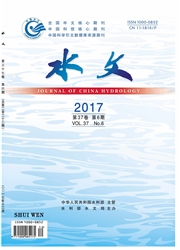

 中文摘要:
中文摘要:
黄土高原地区淤地坝分布密集,对天然产汇流过程扰动较大,给径流还原或水资源评价带来了极大的影响。因此,研究淤地坝影响下的径流还原计算方法对区域水资源评价或径流设计有重要意义。以黑木头川流域为研究对象,分别采用还原系数法和径流系数法计算了殿市水文站控制产汇流区的淤地坝逐年拦蓄水量,并将两种方法的结果进行对比,论证了还原系数法的适用性。还原系数法的计算结果表明:1971-2007年殿市水文站产流区内的淤地坝平均年拦蓄水量为86.21×104m3,与径流系数法计算所得到的拦蓄水量基本一致,相对误差仅为1.36%。同时,研究发现单位控制面积分摊后的拦蓄水量在年际变化上并不显著,基本维持在某一区间内。研究结果表明还原系数法不仅可用于洪水还原,也可较为准确地计算淤地坝影响区的淤地坝拦蓄变量。作为河川径流还原计算方法或淤地坝影响的黄土高原地区水资源评价研究的计算方法之一,可与径流系数法进行交叉验证,进而获得比较准确的淤地坝拦蓄水量。且由于淤地坝年拦水量空间分摊后,单位控制面积的拦水量基本稳定,故在淤地坝上游无明显人类活动的情况下,可据此初估已知或近似区域淤地坝控制流域面积条件下的淤地坝年拦蓄水量,为黄土高原地区今后开展水资源评价和径流预报提供一条简单的途径。
 英文摘要:
英文摘要:
The warping dams are very widely used in the Loess Plateau to control soil erosion. Unfortunately,they have a strong impact on the natural runoff process and bring enormous influence on water resources assessment and water engineering design while they play an important role in regional water and soil conservation. Therefore, it is of great importance to accurately evaluate regional water resources that how to calculate runoff impounded by the warping dams. The present study applied the reduction co- efficient method and runoff coefficient method to calculate the annual water impounded by the warping dams in the Heimutouchuan Watershed (HW). By comparing the computed results of two methods, it explored the suitability and effectiveness of the reduction coefficient method for calculating impounded water in the warping dams. The results show that the average annual impounded water of the warping dams is 862.1x10^3 m3 in the HW during 1971-2007, which is similar with the result computed by runoff coefficient method with the only 1.36% error. In addition, we noticed something interesting that the impounded water on unit area is roughly stable, namely changing in a small range after dividing the impounded water by the catchment area. The above results indicate that the reduction coefficient method is a sort of efficient calculation method for the water impounded by the warping dams, which can be used to evaluate regional water resources in the Loess Plateau region influenced by the warping dams. When combined with the runoff coefficient method, it may be expected to get a more accurate impounded water. On the side, since the impounded water on unit area is stable in the area without human activities obviously, we can roughly calculate the impounded water by the warping dams only depending on the unit impounded water when the catchment area of warping dams is known in a catchment. It is greatly significant to regional water assessment and runoff forecasting in the Loess Plateau region in the future.
 同期刊论文项目
同期刊论文项目
 同项目期刊论文
同项目期刊论文
 期刊信息
期刊信息
